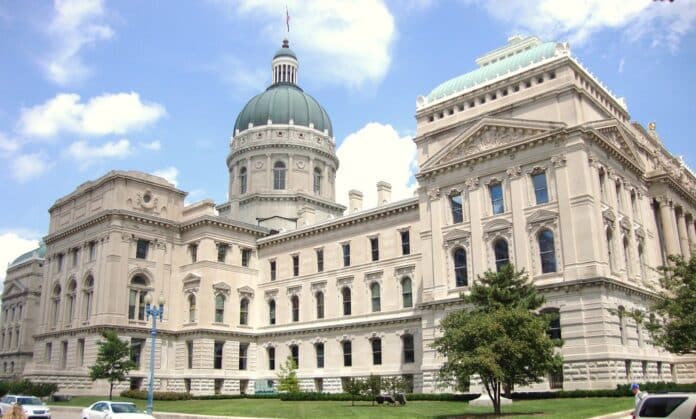GREENFIELD — When Common Cause policy director Julia Vaughn needed an example of what partisan redistricting looks like in Indiana’s 6th Congressional District, she used state Senate District 28, represented by Sen. Mike Crider, R-Greenfield, as a prime example.
“It’s kind of a regularly-shaped district, right, for the most part, except for this weird appendage,” Vaughn said, pointing out the unusual sliver of the district — which includes most of Hancock County — that extends into Indianapolis.
For Vaughn, the seemingly arbitrary inclusion of Warren Township — which is urban, racially diverse, and mostly Democratic — in a state Senate district that is otherwise rural, mostly white and mostly Republican illustrates what can happen when district boundaries are drawn with the goal of keeping one party in power.
As part of the Indiana Coalition for Independent Redistricting, that’s what Vaughn and her organization hope to change, and they recently asked voters from the 6th District for input on how it should be done.
In a parallel to the 2021 redistricting process, the coalition has created a Citizens’ Redistricting Commission, composed of three Republicans, three Democrats and three members who are neither. The commission has been holding meetings in each of Indiana’s congressional districts to ask members of the public what priorities they think should be of the highest importance in creating new districts. It plans to deliver its findings to the Indiana General Assembly and to hold a contest to invite people to submit their own redistricting maps in accordance with what Hoosiers want to see.
“The idea is, if the general assembly won’t reform the system, then we will create our own process and show them how it should be done,” Vaughn said.
The meeting for the 6th District was held on Tuesday, March 16, and attracted a variety of participants from throughout the district.
Vaughn, whose work for Common Cause has focused on everything from government transparency to voting rights, asked those in attendance to consider a variety of factors when thinking about what should be considered most in the redistricting process. For example, should new district lines take into consideration whether an incumbent representative will be drawn out of their district? Should they be geographically compact and make sure communities generally remain within one district? Or should they focus on creating competitive districts that will lead to closer elections?
For some in attendance, the last factor is an important one.
“Competitiveness is far and away the most important criterion for me,” attendee Joanna Swan said. “I have encountered so many potential voters who just don’t bother because… they are convinced their voice doesn’t matter.”
State Rep. Sue Errington, D-Muncie, spoke during the meeting about the impact partisan redistricting — often called gerrymandering — can have in dividing communities. Out of the five state representatives and two state senators who represent some part of Delaware County, she is one of only two who live in the county, she said. The others tend to be more in tune with what’s going on in the communities where they actually live, she said.
“I know that I can give Delaware County a lot more attention than if I had to divide myself between two counties,” she said.
Gerrymandering can also reduce competition, Errington said. Once a state senator in a district with a fairly even party split, she was drawn out of the district in 2011 after a narrow loss in 2010 and ran for the House of Representatives instead in 2012. Now, she rarely faces a serious Republican opponent in her heavily Democratic district. Her old Senate district, meanwhile, has been safely in Republican hands ever since.
“My primaries have always been more competitive since I’ve been in the Muncie House district,” she said of her campaigns against other Democrats in District 34.
Paulette Vandegriff, a leader of the League of Women Voters Hancock County who attended the virtual meeting, said the 2011 redistricting process was a disappointment. That year, several map options were released publicly, but the legislature made a final choice shortly afterward.
“There were better maps drawn than the one that we wound up with,” she said. “I’m hoping this time that there will be more time and more opportunity for citizens to actually comment on the maps… The process was rushed, and obviously the representatives and senators that were there didn’t pay a lot of attention.”
The maps will be based on new census figures. With census results delayed by several months, the state legislature will have to reconvene this fall for a special session to complete the redistricting process. The coalition hopes to use that time to advocate for changes to the process.
When the Indiana General Assembly finalizes its process, Vaughn said she would like to see it release the criteria it used to make those decisions. She’d also like the legislature to provide online mapping tools that will help Hoosiers visualize where the new lines of the districts fall.
Leigh Morris, a former mayor of La Porte who is serving on the Citizens’ Redistricting Commission, said he hopes legislators will remember that Democrats are not the only ones who care about the issue of redistricting. As a Republican, he said, he cares about fair representation and knows that gerrymandering can be used by those on either side of the aisle.
“I hope that we’ll be able to bring public opinion to bear on the Indiana General Assembly,” he said.
[sc:pullout-title pullout-title=”Learn more” ][sc:pullout-text-begin]
For more information on the Indiana Citizens’ Redistricting Commission and how to get involved, visit allinfordemocracy.org.
[sc:pullout-text-end]

